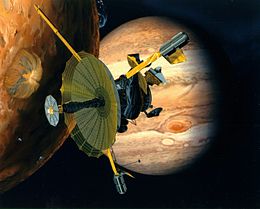
Back Galileo-ruimtesending Afrikaans غاليليو (مسبار فضائي) Arabic Galileo (saagh spoar) GV გალილეო (კოსმოსური აპარატი) Georgian ဂယ်လီလီယို အာကာသယာဉ် Burmese Galileo (spacecraft) SIMPLE Galileo (tàu vũ trụ) Vietnamese 伽利略号探测器 Chinese
 Artist's concept of Galileo at Io with Jupiter in the background. In reality, the high-gain foldable antenna failed to deploy in flight. | |||||||||||||||||||||||
| Names | Jupiter Orbiter Probe | ||||||||||||||||||||||
|---|---|---|---|---|---|---|---|---|---|---|---|---|---|---|---|---|---|---|---|---|---|---|---|
| Mission type | Jupiter orbiter | ||||||||||||||||||||||
| Operator | NASA | ||||||||||||||||||||||
| COSPAR ID | 1989-084B | ||||||||||||||||||||||
| SATCAT no. | 20298 | ||||||||||||||||||||||
| Website | solarsystem | ||||||||||||||||||||||
| Mission duration |
| ||||||||||||||||||||||
| Distance travelled | 4,631,778,000 km (2.88 billion mi)[1] | ||||||||||||||||||||||
| Spacecraft properties | |||||||||||||||||||||||
| Manufacturer | |||||||||||||||||||||||
| Launch mass | |||||||||||||||||||||||
| Dry mass | |||||||||||||||||||||||
| Payload mass | |||||||||||||||||||||||
| Power | |||||||||||||||||||||||
| Start of mission | |||||||||||||||||||||||
| Launch date | October 18, 1989, 16:53:40 UTC | ||||||||||||||||||||||
| Rocket | Space Shuttle Atlantis STS-34/IUS | ||||||||||||||||||||||
| Launch site | Kennedy LC-39B | ||||||||||||||||||||||
| Entered service | December 8, 1995, 01:16 UTC SCET | ||||||||||||||||||||||
| End of mission | |||||||||||||||||||||||
| Disposal | Controlled entry into Jupiter | ||||||||||||||||||||||
| Decay date | September 21, 2003, 18:57:18 UTC | ||||||||||||||||||||||
| |||||||||||||||||||||||

Large Strategic Science Missions Planetary Science Division | |||||||||||||||||||||||
Galileo was an American robotic space probe that studied the planet Jupiter and its moons, as well as the asteroids Gaspra and Ida. Named after the Italian astronomer Galileo Galilei, it consisted of an orbiter and an entry probe. It was delivered into Earth orbit on October 18, 1989, by Space Shuttle Atlantis, during STS-34. Galileo arrived at Jupiter on December 7, 1995, after gravitational assist flybys of Venus and Earth, and became the first spacecraft to orbit an outer planet.[4]
The Jet Propulsion Laboratory built the Galileo spacecraft and managed the Galileo program for NASA. West Germany's Messerschmitt-Bölkow-Blohm supplied the propulsion module. NASA's Ames Research Center managed the atmospheric probe, which was built by Hughes Aircraft Company. At launch, the orbiter and probe together had a mass of 2,562 kg (5,648 lb) and stood 6.15 m (20.2 ft) tall.
Spacecraft are normally stabilized either by spinning around a fixed axis or by maintaining a fixed orientation with reference to the Sun and a star. Galileo did both. One section of the spacecraft rotated at 3 revolutions per minute, keeping Galileo stable and holding six instruments that gathered data from many different directions, including the fields and particles instruments.
Galileo was intentionally destroyed in Jupiter's atmosphere on September 21, 2003. The next orbiter to be sent to Jupiter was Juno, which arrived on July 5, 2016.
- ^ "The Final Day on Galileo" (Press release). Jet Propulsion Laboratory. September 21, 2003. Archived from the original on September 30, 2023.
- ^ a b c d e f g h i j k l m "Galileo Jupiter Arrival" (PDF) (Press Kit). NASA / Jet Propulsion Laboratory. December 1995.
- ^ Taylor, Cheung & Seo 2002, p. 86.
- ^ "Galileo – Overview". NASA Solar System Exploration. Retrieved December 7, 2021.